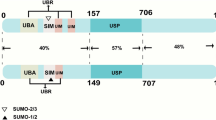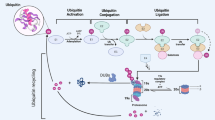Abstract
USP32, on chromosomal band 17q23.1-17q23.2, is a highly conserved but uncharacterized gene that gave rise during evolution to a well-known hominoid-specific proto-oncogene, USP6. We investigated the expression profile of USP32 in human tissues and examined its functions to gain insight into this novel member of the well-conserved ubiquitination system. We detected ubiquitous USP32 expression across tissues and confirmed the predicted deubiquitination function owing to the presence of conserved peptidase signature aspargine, cysteine, histidine, and aspartic acid domains of ubiquitin-specific proteases. A Golgi localization of GFP-fused USP32 was detected by fluorescent protection assay and BODIPY-TR staining. In addition, stable silencing of USP32 caused a significant decrease in the proliferation and migration rate of cells. Based on these and the fact that USP32 maps to 17q23, which is commonly amplified in breast cancers, we analyzed USP32 expression in breast cancer cells. We detected high expression of USP32 in 50% (9 of 18) of breast cancer cell lines and 22% (9 of 41) of primary breast tumors compared to mammary epithelial cells. In summary, we report the preliminary characterization of this novel deubiquitinating enzyme on 17q23 and demonstrate its functional role in the ubiquitin system and its potential involvement in tumorigenesis.





Similar content being viewed by others
References
Baker RT, Tobias JW, Varshavsky A (1992) Ubiquitin-specific proteases of Saccharomyces cerevisiae. Cloning of UBP2 and UBP3, and functional analysis of the UBP gene family. J Biol Chem 267:23364–23375
Bärlund M, Tirkkonen M, Forozan F, Tanner M, Kallioniemi O et al (1997) Increased copy number at 17q22–q24 by CGH in breast cancer is due to high-level amplification of two separate regions. Genes Chromosom Cancer 20:372–376
Cimen I, Tunçay S, Banerjee S (2009) 15-Lipoxygenase-1 expression suppresses the invasive properties of colorectal carcinoma cell lines HCT-116 and HT-29. Cancer Sci 100:2283–2291
Cohen M, Stutz F, Belgareh N, Haguenauer-Tsapis R, Dargemont C (2003a) Ubp3 requires a cofactor, Bre5, to specifically de-ubiquitinate the COPII protein, Sec23. Nat Cell Biol 5:661–667
Cohen M, Stutz F, Dargemont C (2003b) Deubiquitination, a new player in Golgi to endoplasmic reticulum retrograde transport. J Biol Chem 278:51989–51992
Couch F, Wang X, Wu G, Qian J, Jenkins R et al (1999) Localization of PS6K to chromosomal region 17q23 and determination of its amplification in breast cancer. Cancer Res 59:1408–1411
Erson A, Niell B, DeMers S, Rouillard J, Hanash S et al (2001) Overexpressed genes/ESTs and characterization of distinct amplicons on 17q23 in breast cancer cells. Neoplasia 3:521–526
Ethier SP, Mahacek ML, Gullick WJ, Frank TS, Weber BL (1993) Differential isolation of normal luminal mammary epithelial cells and breast cancer cells from primary and metastatic sites using selective media. Cancer Res 53:627–635
Ethier SP, Kokeny KE, Ridings JW, Dilts CA (1996) erbB family receptor expression and growth regulation in a newly isolated human breast cancer cell line. Cancer Res 56:899–907
Forbes SA, Bhamra G, Bamford S, Dawson E, Kok C et al (2008) The catalogue of somatic mutations in cancer (COSMIC). Curr Protoc Hum Genet Chapter 10:10.11
Grigoriadis A, Mackay A, Reis-Filho JS, Steele D, Iseli C et al (2006) Establishment of the epithelial-specific transcriptome of normal and malignant human breast cells based on MPSS and array expression data. Breast Cancer Res 8:R56
Haverty P, Fridlyand J, Li L, Getz G, Beroukhim R et al (2008) High-resolution genomic and expression analyses of copy number alterations in breast tumors. Genes Chromosom Cancer 47:530–542
Hussain S, Zhang Y, Galardy PJ (2009) DUBs and cancer: the role of deubiquitinating enzymes as oncogenes, non-oncogenes and tumor suppressors. Cell Cycle 8:1688–1697
Ignatoski KM, Ethier SP (1999) Constitutive activation of pp125fak in newly isolated human breast cancer cell lines. Breast Cancer Res Treat 54:173–182
Jonsson G, Naylor TL, Vallon-Christersson J, Staaf J, Huang J et al (2005) Distinct genomic profiles in hereditary breast tumors identified by array-based comparative genomic hybridization. Cancer Res 65:7612–7621
Kraft C, Deplazes A, Sohrmann M, Peter M (2008) Mature ribosomes are selectively degraded upon starvation by an autophagy pathway requiring the Ubp3p/Bre5p ubiquitin protease. Nat Cell Biol 10:602–610
Livak KJ, Schmittgen TD (2001) Analysis of relative gene expression data using real-time quantitative PCR and the 2(-delta delta C(T)) method. Methods 25:402–408
Lorenz H, Hailey D, Wunder C, Lippincott-Schwartz J (2006) The fluorescence protease protection (FPP) assay to determine protein localization and membrane topology. Nat Protoc 1:276–279
Maglott D, Ostell J, Pruitt KD, Tatusova T (2007) Entrez Gene: gene-centered information at NCBI. Nucleic Acids Res 35:D26–D31
Meyer HH (2005) Golgi reassembly after mitosis: the AAA family meets the ubiquitin family. Biochim Biophys Acta 1744:108–119
Nakamura T, Hillova J, Mariage-Samson R, Onno M, Huebner K et al (1992) A novel transcriptional unit of the tre oncogene widely expressed in human cancer cells. Oncogene 7:733–741
Natrajan R, Lambros MB, Rodriguez-Pinilla SM, Moreno-Bueno G, Tan DS et al (2009) Tiling path genomic profiling of grade 3 invasive ductal breast cancers. Clin Cancer Res 15:2711–2722
Nijman SM, Luna-Vargas MP, Velds A, Brummelkamp TR, Dirac AM et al (2005) A genomic and functional inventory of deubiquitinating enzymes. Cell 123:773–786
Oliveira AM, Hsi BL, Weremowicz S, Rosenberg AE, Dal Cin P et al (2004) USP6 (Tre2) fusion oncogenes in aneurysmal bone cyst. Cancer Res 64:1920–1923
Oliveira AM, Chou MM, Perez-Atayde AR, Rosenberg AE (2006) Aneurysmal bone cyst: a neoplasm driven by upregulation of the USP6 oncogene. J Clin Oncol 24:e1; author reply e2
Panagopoulos I, Mertens F, Lofvenberg R, Mandahl N (2008) Fusion of the COL1A1 and USP6 genes in a benign bone tumor. Cancer Genet Cytogenet 180:70–73
Papa F, Hochstrasser M (1993) The yeast DOA4 gene encodes a deubiquitinating enzyme related to a product of the human tre-2 oncogene. Nature 366:313–319
Pärssinen J, Kuukasjärvi T, Karhu R, Kallioniemi A (2007) High-level amplification at 17q23 leads to coordinated overexpression of multiple adjacent genes in breast cancer. Br J Cancer 96:1258–1264
Paulding CA, Ruvolo M, Haber DA (2003) The Tre2 (USP6) oncogene is a hominoid-specific gene. Proc Natl Acad Sci USA 100:2507–2511
Piper RC, Luzio JP (2007) Ubiquitin-dependent sorting of integral membrane proteins for degradation in lysosomes. Curr Opin Cell Biol 19:459–465
Scafoglio C, Ambrosino C, Cicatiello L, Altucci L, Ardovino M et al (2006) Comparative gene expression profiling reveals partially overlapping but distinct genomic actions of different antiestrogens in human breast cancer cells. J Cell Biochem 98:1163–1184
Sinclair C, Rowley M, Naderi A, Couch F (2003) The 17q23 amplicon and breast cancer. Breast Cancer Res Treat 78:313–322
Wang Y, Satoh A, Warren G, Meyer HH (2004) VCIP135 acts as a deubiquitinating enzyme during p97–p47-mediated reassembly of mitotic Golgi fragments. J Cell Biol 164:973–978
Wiemann S, Weil B, Wellenreuther R, Gassenhuber J, Glassl S et al (2001) Toward a catalog of human genes and proteins: sequencing and analysis of 500 novel complete protein coding human cDNAs. Genome Res 11:422–435
Yuan J, Luo K, Zhang L, Cheville JC, Lou Z (2010) USP10 regulates p53 localization and stability by deubiquitinating p53. Cell 140:384–396
Yuasa-Kawada J, Kinoshita-Kawada M, Rao Y, Wu JY (2009) Deubiquitinating enzyme USP33/VDU1 is required for Slit signaling in inhibiting breast cancer cell migration. Proc Natl Acad Sci USA 106:14530–14535
Zhang Y, Martens JW, Yu JX, Jiang J, Sieuwerts AM et al (2009) Copy number alterations that predict metastatic capability of human breast cancer. Cancer Res 69:3795–3801
Acknowledgments
This project was funded by the Scientific and Technological Research Council of Turkey (TUBITAK) (104S241, 108S408) and METU internal funds. A. Sapmaz is funded by OYP (YYU, Van). Contributions by J. Keller and E. Petty were supported by NIH-NCI RO1 CA72877-01A1. We thank Drs. C. Yakicier and U. Tazebay for sharing resources, T. Acun for technical help, Drs. C. Ozen, P. Ballar, and C. Son for guidance with microscopy, Dr. M. Gürsel for flow cytometry, Dr. M. Hochstrasser for constructs/protocols, and Dr. V. Seyrantepe for pEGFP vectors.
Author information
Authors and Affiliations
Corresponding author
Additional information
S. Akhavantabasi, H. B. Akman, and A Sapmaz contributed equally to this work.
Electronic supplementary material
Below is the link to the electronic supplementary material.
Rights and permissions
About this article
Cite this article
Akhavantabasi, S., Akman, H.B., Sapmaz, A. et al. USP32 is an active, membrane-bound ubiquitin protease overexpressed in breast cancers. Mamm Genome 21, 388–397 (2010). https://doi.org/10.1007/s00335-010-9268-4
Received:
Accepted:
Published:
Issue Date:
DOI: https://doi.org/10.1007/s00335-010-9268-4




